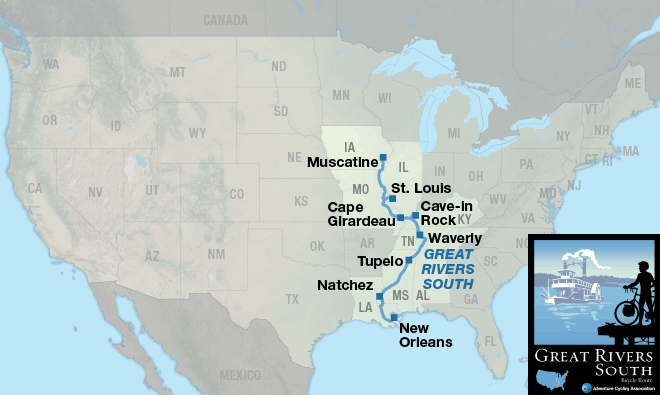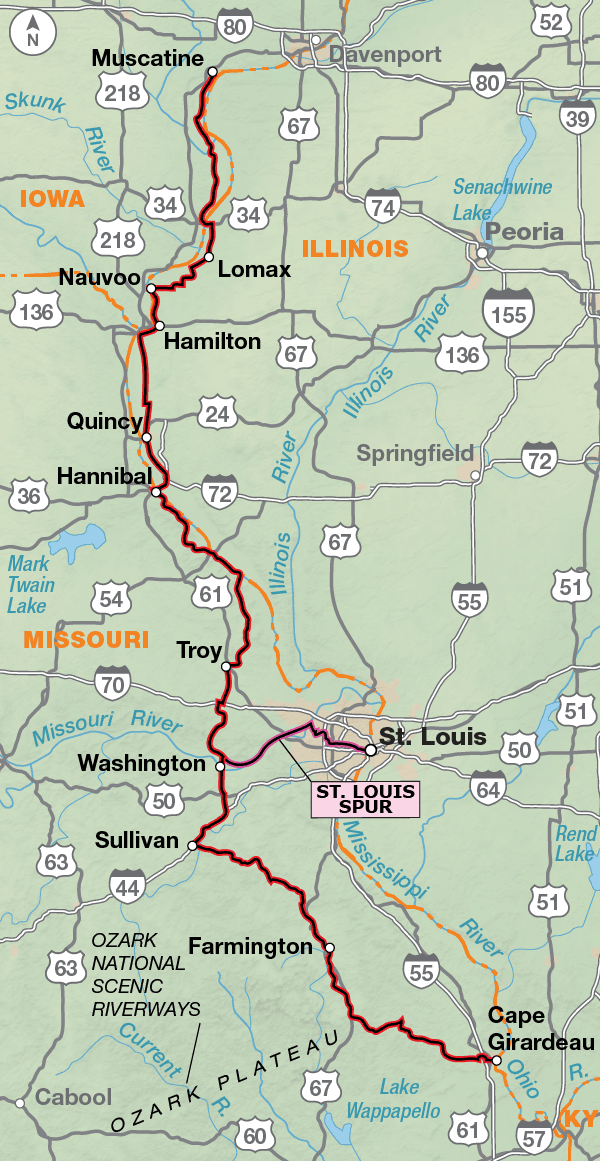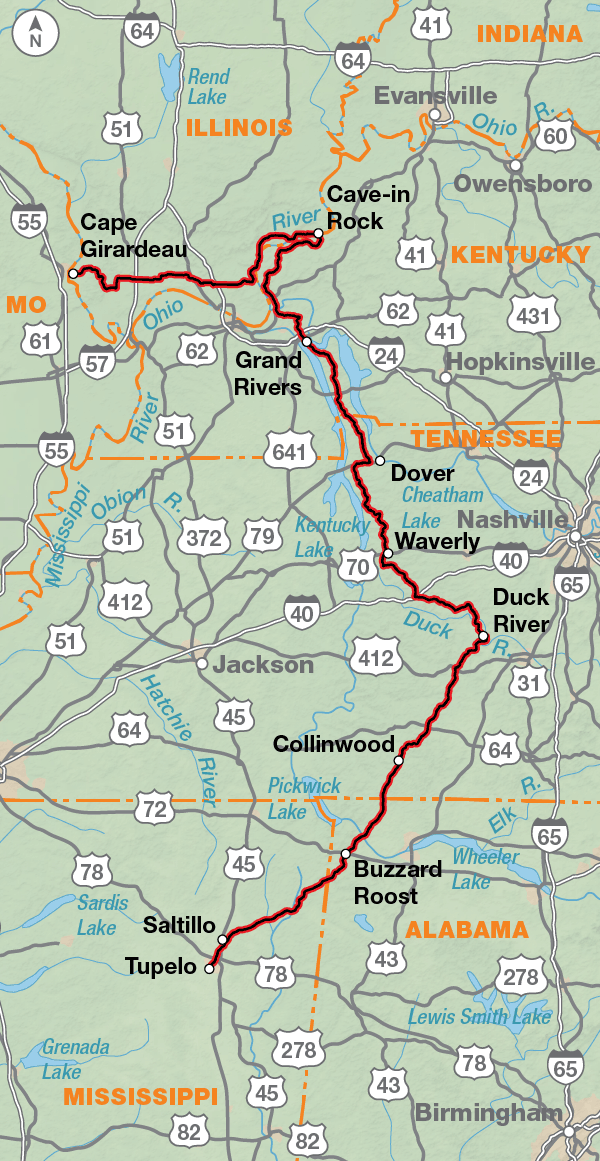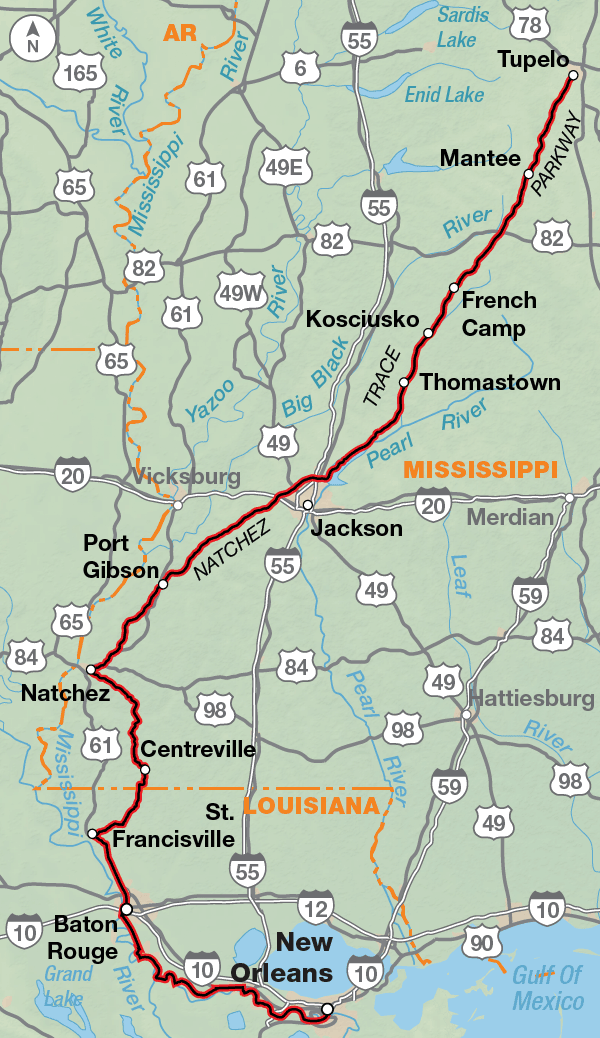Great Rivers South
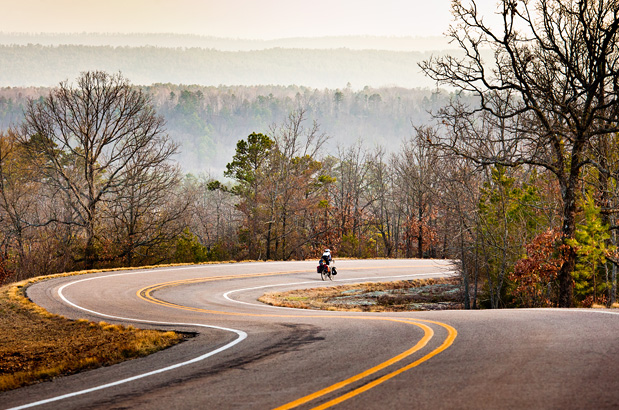
| Great Rivers South Muscatine, IA to New Orleans, LA 3 Map Set | GPX Data | Overview | Buy | Mobile App |
|---|---|
| 1. Muscatine, IA to Cape Girardeau, MO | Detail |
| 2. Cape Girardeau, MO to Tupelo, MS | Detail |
| 3. Tupelo, MS to New Orleans, LA | Detail |
Experience history of Mormons, Mark Twain, Mississippi, and much more.
The Great Rivers South Bicycle Route boasts a subtle beauty, replete with farmland, woods, caverns, rivers, and waterfalls. There’s quite a bit of history along the route as you’ll see in Nauvoo, Illinois, the town from which the Mormons were driven out in the 1800s, and Hannibal, Missouri, Mark Twain’s hometown. You’ll also pass a pirate’s cave on the Ohio River, an old Civil War fort, and antebellum homes in Natchez, Mississippi.
Although titled the Great Rivers South Bicycle Route, you’ll hardly ride any long stretches along rivers. Instead, you’ll cross many of the great rivers that feed into the Mississippi.
Starting in Muscatine, Iowa, you ride on the west side of the river, beside the Mark Twain National Wildlife Refuge. You’ll particularly enjoy the 11-mile stretch between Nauvoo and Hamilton, where you’ll be alongside the Mississippi River. After crossing the bridge into Hannibal, Missouri, you will see a town most famous as the boyhood home of Samuel Clemens (a.k.a. Mark Twain). This town has tourist sites based on characters and places from his books, e.g., Tom Sawyer’s fence, Becky Thatcher’s home, Grant’s Drug Store, and Mark Twain’s Cave. Heading southward, you’ll encounter hilly farm country. If you want, you can take a side trip into St. Louis to see the famous Gateway Arch.
Be prepared to use your granny gears off and on through the Ozark Mountain Range until Cape Girardeau, Missouri, where you cross back into Illinois. This means more farm country, and then you’ll cross the Ohio River by ferry into Kentucky. You’ll be using your granny gears again, and then you’ll enjoy a very pleasant ride along The Trace Road in the Land Between the Lakes Recreation Area, an expanse of woods where buffalo roam. No commercial vehicles are allowed on this road, and a 45 mph speed limit is strictly enforced.
The route on the Natchez Trace follows a two-lane road in a national park that continues through Alabama and Mississippi, with no commercial traffic or services permitted. All services, except for occasional campgrounds, are off the route in nearby towns. You’ll encounter fellow bicyclists and enjoy many hiking trails, boardwalks, waterfalls, and historical sites along the Trace. At the end of the Trace, you can visit the antebellum homes in Natchez, Mississippi. The route goes through the rural countryside in northern Louisiana. Between Baton Rouge and New Orleans the route follows portions of the mostly paved Mississippi River Levee Path.
Photo by Adam Coppola
From Muscatine, Iowa to Hannibal, Missouri, you’ll be riding in the relatively flat floodplain of the Mississippi River. South of Hannibal the route follows river bluffs with steep, roller coaster hills. After leaving the river, you’ll be in Missouri hill country with many farms in the valleys. Before crossing the Missouri River, you’ll ride 3.9 miles on the crushed limestone KATY Trail before entering the Ozark Mountains which give way to the alluvial plains returning to the Mississippi River. Across Kentucky and Tennessee moderate to challenging rolling hills are the norm until you reach the more gently graded Natchez Trace. From Natchez, Mississippi to Baton Rouge, Louisiana the route returns to gently rolling hills through rural farmlands. The route is flat between Baton Rouge and New Orleans.
| Great Rivers South - Main Route | ||||
|---|---|---|---|---|
| Section | Distance | Elevation | Total Climb | Avg. Climb/mile |
| Total | 1385.0 miles | Minimum: 0 ft.Maximum:1,080 ft. | 62,450 ft. south bound63,410 ft. north bound | 45 ft. per mi. south bound46 ft. per mi. north bound |
| 1 | 452.7 miles | Minimum: 680 ft.Maximum:1,080 ft. | 22,460 ft. south bound22,885 ft. north bound | 50 ft. per mi. south bound51 ft. per mi. north bound |
| 2 | 451.5 miles | Minimum: 270 ft.Maximum:1,080 ft. | 25,870 ft. south bound26,120 ft. north bound | 57 ft. per mi. south bound58 ft. per mi. north bound |
| 3 | 480.5 miles | Minimum: 0 ft.Maximum:575 ft. | 14,120 ft. south bound14,405 ft. north bound | 29 ft. per mi. south bound30 ft. per mi. north bound |
| Great Rivers South Alternates | ||||
|---|---|---|---|---|
| Name | Section | Distance | Total Climb | Avg. Climb/mile |
| St. Louis Spur | 1 | 57.7 miles | 1,630 ft. east bound1,665 ft. west bound | 28 ft. per mi. east bound29 ft. per mi. west bound |
| Bike Path Option | 3 | 10.7 miles | 645 ft. south bound620 ft. north bound | 60 ft. per mi. south bound58 ft. per mi. north bound |
The Great Rivers South Bicycle Route can be ridden from mid-spring to late fall (typically April to October), and even into the winter on the southern portion. Due to changing local conditions, it is difficult to predict any major wind patterns. High summer temperatures and humidity can cause discomfort if you’re not used to either. Tornadoes are common in Illinois and Missouri. They occur mostly in May and June. Facilities and services are limited along the Natchez Trace and camping usually primitive when available.
Some campgrounds will charge a cyclist traveling alone less if they have hiker/biker sites, but often they will charge the price of a regular tent or RV site, and that can easily be $10-$40/night. The maps list churches that have opened their doors to cyclists, but they aren’t all that closely spaced. If you’re friendly and ask around, you can often get yourself invited to camp in a yard. Our routes goes through national forests (moreso in the west) and you are allowed to camp anywhere on national forest land as long as you “pack it in, pack it out.” Many city parks are free to camp in.
You may also wish to sign up with Warmshowers, a reciprocal hospitality site for bicycle travelers, for other overnight options.
Route Highlights
Great Rivers South Highlights
- Nauvoo State Park, Section 1
- Mark Twain Boyhood Home & Museum, Section 1
- Katy Trail/St. Louis Spur, Section 1
- Cave-In-Rock State Park, Section 2
- Woodlands Trace National Scenic Byway, Section 2
- Natchez Trace Parkway, Section 2 & 3
- Meriwether Lewis National Monument, Section 2
- Tupelo National Battlefield, Section 2
- Elvis Presley Birthplace, Section 3
- Ruins of Windsor, Section 3
- Port Hudson State Commemorative Area, Section 3
More Route Resources
- No-Turn-Away Bike Camping Policies (Missouri and Tennessee)
- Katy Trail State Park (Missouri)
- Amtrak into St. Louis (Missouri)
- How to Deal with Loose Dogs
- Cave-In-Rock ferry (Ohio River crossing between Illinois and Kentucky)
- Land Between the Lakes National Recreation Area (Kentucky)
- Natchez Trace Parkway (Tennessee, Alabama, Mississippi)
- Mississippi River Levee Path status (Louisiana)
- Connect and share photos with other riders on Instagram: #acaGrRivers
Updates to Recently Released Maps
If you are planning a bike tour, be sure to get the most recent map updates and corrections for your route by selecting the route, and the appropriate section(s), from the drop-down menu below.
Over time maps become less useful because things change. Every year Adventure Cycling’s Routes and Mapping Department create map updates and corrections for every map in the Adventure Cycling Route Network, which now totals 52,047 miles. With the help of touring cyclists like you, we receive updates on routing, services, camping, and contact information. Until we can reprint the map with the new information, we verify the suggested changes and publish corrections and updates here on our website.
PLEASE NOTE: Covid has been particularly hard on the small businesses along our routes. While we do our best to keep the maps and these online updates current, you may encounter more closed businesses and longer stretches with limited or no services.
Refer to these updates for the most current information we have and submit reports of changes to the Route Feedback Form for the cyclists coming after you.
NOTE: Map updates and corrections only pertain to long term changes and updates. For short term road closures, please see the Adventure Cycling’s Routes Temporary Road Closures discussion in our Forums.
